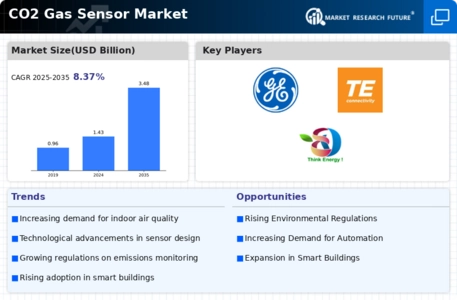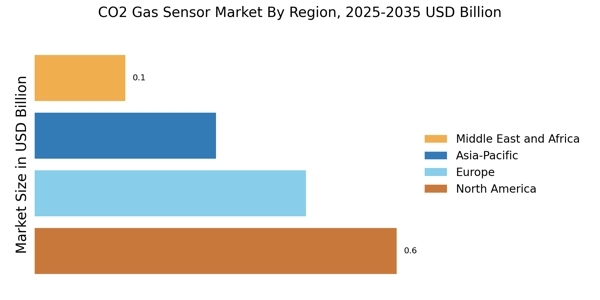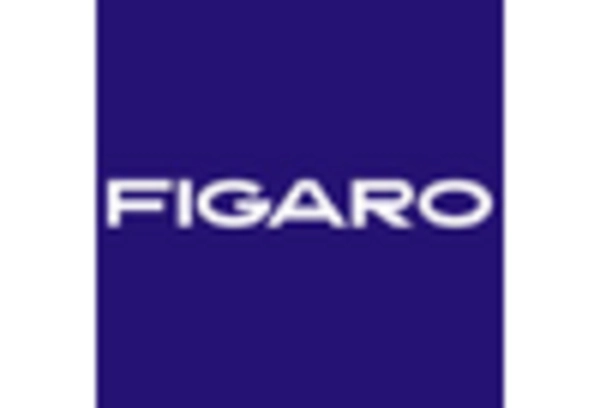Rising Awareness of Air Quality
The growing awareness of air quality and its impact on health is a key driver for the CO2 Gas Sensor Market. As individuals and organizations become more conscious of the effects of poor air quality, the demand for CO2 sensors is increasing. This trend is particularly evident in urban areas, where pollution levels are often higher. The market is projected to grow as consumers seek solutions to monitor and improve indoor air quality, especially in residential and commercial buildings. Additionally, educational campaigns and public health initiatives are likely to further elevate awareness, leading to increased adoption of CO2 sensors. The CO2 Gas Sensor Market is thus positioned for growth, as stakeholders recognize the importance of maintaining healthy air quality standards.
Emerging Markets and Economic Growth
The CO2 Gas Sensor Market is benefiting from economic growth in emerging markets, where industrialization and urbanization are on the rise. As countries develop, there is a growing need for effective air quality management solutions, including CO2 sensors. The expansion of manufacturing and construction sectors in these regions is likely to drive demand for monitoring solutions to comply with environmental regulations. Additionally, increased investment in infrastructure and smart city projects is expected to further propel the market. The CO2 Gas Sensor Market may see a notable increase in adoption rates as these economies prioritize sustainable development and environmental protection. This trend suggests a promising outlook for the market, with emerging economies playing a crucial role in its expansion.
Industrial Applications Driving Demand
The CO2 Gas Sensor Market is witnessing a surge in demand driven by various industrial applications. Industries such as food and beverage, pharmaceuticals, and agriculture are increasingly utilizing CO2 sensors for process control and quality assurance. For example, in the food industry, CO2 levels are monitored to ensure optimal storage conditions and extend shelf life. The market is expected to expand as more industries recognize the benefits of CO2 monitoring in enhancing operational efficiency and product quality. Furthermore, the integration of CO2 sensors in automated systems is likely to streamline processes and reduce costs. As industries continue to evolve, the CO2 Gas Sensor Market is poised for substantial growth, with an increasing number of applications emerging.
Regulatory Influence on Emission Standards
The CO2 Gas Sensor Market is significantly influenced by stringent regulatory frameworks aimed at reducing carbon emissions. Governments worldwide are implementing policies that mandate the monitoring of CO2 levels in various sectors, including manufacturing, transportation, and energy production. For instance, regulations requiring continuous emissions monitoring systems (CEMS) are driving the adoption of advanced CO2 sensors. The market is expected to benefit from these regulations, as industries seek compliance to avoid penalties and enhance their sustainability profiles. The increasing focus on environmental protection is likely to propel the demand for CO2 gas sensors, with the market projected to reach a valuation of several billion dollars by the end of the decade. This regulatory push not only fosters innovation but also encourages investment in the CO2 Gas Sensor Market.
Technological Advancements in CO2 Gas Sensors
The CO2 Gas Sensor Market is experiencing rapid technological advancements that enhance sensor accuracy and efficiency. Innovations such as miniaturization and integration with IoT devices are becoming prevalent. These advancements allow for real-time monitoring and data collection, which is crucial for various applications, including indoor air quality management and industrial processes. The market is projected to grow at a compound annual growth rate (CAGR) of approximately 10% over the next five years, driven by these technological improvements. Furthermore, the development of low-power sensors is likely to expand their applicability in remote and battery-operated devices, thereby increasing market penetration. As technology continues to evolve, the CO2 Gas Sensor Market is expected to witness a surge in demand, particularly in smart building applications.

















Leave a Comment